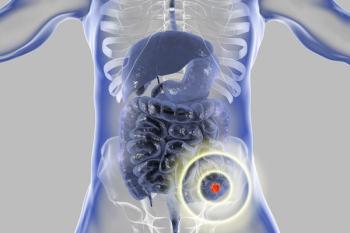
- ONCOLOGY Vol 11 No 7
- Volume 11
- Issue 7
Colorectal Cancer Surgical Practice Guidelines
The Society of Surgical Oncology surgical practice guidelines focus on the signs and symptoms of primary cancer, timely evaluation of the symptomatic patient, appropriate preoperative evaluation for extent of disease, and role of the surgeon in
The Society of Surgical Oncology surgical practice guidelines focuson the signs and symptoms of primary cancer, timely evaluation of the symptomaticpatient, appropriate preoperative evaluation for extent of disease, androle of the surgeon in diagnosis and treatment. Separate sections on adjuvanttherapy, follow-up programs, or management of recurrent cancer have beenintentionally omitted. Where appropriate, perioperative adjuvant combined-modalitytherapy is discussed under surgical management. Each guideline is presentedin minimal outline form as a delineation of therapeutic options.
Since the development of treatment protocols was not the specific aimof the Society, the extensive development cycle necessary to produce evidence-basedpractice guidelines did not apply. We used the broad clinical experienceresiding in the membership of the Society, under the direction of AlfredM. Cohen, MD, Chief, Colorectal Service, Memorial Sloan-Kettering CancerCenter, to produce guidelines that were not likely to result in significantcontroversy.
Following each guideline is a brief narrative highlighting and expandingon selected sections of the guideline document, with a few relevant references.The current staging system for the site and approximate 5-year survivaldata are also included.
The Society does not suggest that these guidelines replace good medicaljudgment. That always comes first. We do believe that the family physician,as well as the health maintenance organization director, will appreciatethe provision of these guidelines as a reference for better patient care.
Symptoms and SignsEarly-stage disease
- Change in frequency, consistency, and shape of bowel movements
- Bleeding: overt or occult
Advanced-stage disease
- For colon carcinoma:
- Colicky abdominal pain
- Abdominal distention, nausea, vomiting
- Obstruction/perforation
- Palpable or visible mass
- Weight loss
- Anemia
- For rectal carcinoma:
- Rectal bleeding, mucus discharge
- Tenesmus
- Rectal pain
- Weight loss
- Constipation
- Diarrhea
- Anemia
Evaluation of the Symptomatic Patient Work-up
- If the patient presents with one episode of bright red blood on toiletpaper, a rectal examination, proctosigmoidoscopy, and reassurance are allthat are needed.
- If the patient has had more than one episode of bleeding, is olderthan age 30, has a family history of colon cancer, has a diagnosis of inflammatorybowel disease, has other gastrointestinal symp- toms or a change in bowelhabits, or is anemic, the following examinations should be performed insequence until a diagnosis is reached:
- Rectal examination
- Proctosigmoidoscopy and/or flexible sigmoidoscopy with biopsy
- Colonoscopy with biopsy (preferred) or double-contrast barium enema
- If the patient presents with occult bleeding or overt bleeding mixedwith stools; a change in the frequency, consistency, and shape of bowelmovements; any of the symptoms of advanced- stage disease, with the exceptionof obstruction or perforation, the following examinations should be performedin sequence until a diagnosis is reached:
- Rectal examination
- Proctosigmoidoscopy and/or flexible sigmoidoscopy with biopsy
- Colonoscopy with biopsy (preferred) or double-contrast barium enema
- When the patient presents with intestinal obstruction:
- Examine for peritoneal signs.
- An abdominal x-ray (flat and upright) will usually reveal the siteof the obstruction.
- A water-soluble contrast enema will clarify the nature of the obstructinglesion.
- The occurrence of free intestinal perforation is usually confirmed byfree air under the diaphragm, best demonstrated in an upright chest, uprightabdominal, or a left decubitus abdominal x-ray.
Appropriate timeliness of surgical referral
- A rectal examination with stool occult blood must be part of the initialevaluation.
- Proctosigmoidoscopy and flexible sigmoidoscopy are office-based proceduresthat require minimal preparation, and one or both procedures can be performedat the time of the original visit.
- A colonoscopy or double-contrast barium enema requires a complete mechanicalbowel preparation. It should be performed at the patient's earliest convenience.
- If a barium enema is obtained, it must be complemented by sigmoidoscopyor at least rigid proctoscopy.
Preoperative Evaluation for Extent of DiseasePhysical examination Chest x-ray CBC and chemistry profile
- The value of carcinoembryonic antigen is unproven.
Abdominal CT scan or liver ultrasound (both unproven)
Rectal cancer
- Pelvic CT in selected patients
- Endorectal ultrasound if treatment will be altered by better definitionof the T-stage.
Colonoscopy or double-contrast barium enema
- To evaluate the rest of the colon
Role of the Surgeon in Initial ManagementEvaluation of the symptomatic patient and diagnostic procedures
- Perform rigid proctosigmoidoscopy, flexible sigmoidoscopy, and colonoscopyif part of the surgeon's standard practice.
- Perform or collaborate on the endorectal ultrasound to optimize staginginformation.
Surgical considerations
- Uncomplicated carcinoma:
- Right colon, hepatic flexure, transverse colon
- Right or extended right colectomy
- Splenic flexure, descending colon
- Left colectomy
- Sigmoid, rectosigmoid, upper rectum
- Anterior resection with preservation of sympathetic nerves
- Mid- and lower rectum
- Low anterior resection or coloanal procedure with preservation of sympathetic and parasympathetic nerves
- Abdominoperineal resection
- Transanal excision/fulguration/adjuvant chemoradiation
- Carcinomas complicated by:
- Obstruction, right colon
- Resection with anastomosis
- Obstruction, left colon
- Operative diversion, then two- or three-stage resection
- Resection with stoma
- Resection, intraoperative bowel lavage, primary anastomosis
- Perforation
- Resection with primary stoma; if sealed, consider resection with anastomosis.
- Invasion of adjacent organs
- In-continuity resection with primary anastomosis
- Localized liver or lung metastasis
- Colon or upper rectum: local resection with primary anastomosis
- Lower rectum: abdominoperineal resection, transrectal fulguration,laser; evaluate for hepatic or lung resection.
- Widespread liver metastasis
- Operate for obstruction or persistent bleeding not amenable to otherpalliative therapies.
These guidelines are copyrighted by the Society of Surgical Oncology(SSO). All rights reserved. These guidelines may not be reproduced in anyform without the express written permission of SSO. Requests for reprintsshould be sent to: James R. Slawny, Executive Director, Society of SurgicalOncology, 85 W Algonquin Road, Arlington Heights, IL 60005.
The incidence of colorectal carcinoma remains fairly stable, with approximately 150,000 new cases diagnosed each year. Males and females are affected equally.On the positive side, most patients are diagnosed with local or regionaldisease.
Patients who are at increased risk for developing colorectal carcinomaare those who have had a previous carcinoma of the colon or rectum, thosewith one or more first-degree relatives who have had colorectal carcinoma,those with familial polyposis, and those with ulcerative colitis of morethan 8 years' duration.
In patients with one or more first-degree relatives with colorectalcancer, a screening examination every 3 to 5 years is recommended. Thisincludes either a full colonoscopy or proctoscopy and barium enema (air-contrast).
When evaluating a patient with suspected colorectal cancer, regardlessof age, one must carefully consider the frequency of symptoms. If an episodeof bleeding is the first and only one, proctoscopy in the office is probablythe only evaluation needed. Although there is still much debate about theefficacy of testing for occult blood in the stool, if it is found on repeatedtests, a full evaluation is in order. A full evaluation is also warrantedin patients who have had multiple episodes of bleeding or who complainof a change in bowel habits, mucus discharge, repeated bleeding, rectalpain, constipation, diarrhea, anemia, or other symptoms that may indicatethe presence of a colorectal carcinoma.
Rectal examination should be part of the initial evaluation in all patients,as should either proctosigmoidoscopy or flexible sigmoidoscopy. In additionto a proctoscopy or sigmoidoscopy, the proximal colon must be evaluatedeither by air-contrast barium enema or colonoscopy. Colonoscopy is preferredbecause of the variation in quality of barium enema examinations, whichincreases the chances of overlooking cancers or significant pathology.Also, during colonoscopy, polyps can be removed and diagnostic biopsiesperformed. If a barium enema is ordered, it must always be complementedby some type of visualization of the rectum, such as sigmoidoscopy or rigidproctoscopy.
In the symptomatic patient, a physical examination, complete blood count,and chemistry profile are performed. A chest x-ray is helpful in excludingobvious pulmonary metastases. An abdominal CT scan or a liver ultrasoundis of no value preoperatively unless one expects to find evidence of diseasethat would change the surgical approach.
Ultrasound evaluation should be ordered for patients with rectal cancersin whom invasion of or adherence to adjacent structures is suspected. Sucha finding may change the recommended treatment, indicating the possibleneed for preoperative radiation with or without concomitant chemotherapy.Endorectal ultrasound will accurately identify tumor invasion through therectal wall. It also has been shown to be far more accurate than CT scanningin evaluating the depth of tumor penetration and will accurately determineinvasion into the prostate or bladder in the male preoperatively.
Patients who present with advanced disease and bowel obstruction shouldbe examined for peritoneal signs. Upright abdominal or chest x-rays canbe used to assess whether or not there is free air under the diaphragm.In the absence of peritoneal signs, a water-soluble contrast enema mayindicate the nature and location of the obstructing lesion.
The role of the surgeon in the initial management of the patient includesthe initial evaluation and the ordering of diagnostic procedures, includingproctosigmoidoscopy, flexible sigmoidoscopy, and colonoscopy, if this ispart of the physician's practice. Either the surgeon or the radiologistperforms and evaluates the endorectal ultrasound scan.
The three main staging systems for colorectal cancer are the Dukes',TNM, and modified Astler-Coller systems. In the United States, the modifiedAstler-Coller system is used most commonly. The TNM system has been modifiedto correlate directly with the Dukes' staging system (Table1).
Astler-Coller's stage A carcinomas are cured following surgery in thevast majority of patients, with a 5-year survival rate more than 90%. Astler-CollerB2 carcinomas, ie, tumors that have penetrated through the muscular layerof the bowel wall, are associated with a somewhat lower survival rate ofapproximately 70% to 80%. In contrast, the cure rate of surgery alone fortumors with lymph node involvement is approximately 50%, and the 5-yearsurvival rate of patients with metastatic disease ranges from 5% to 10%.
Surgery for uncomplicated carcinomas is fairly straightforward. Rightcolon hepatic flexure and transverse colon carcinomas are treated by rightor extended right hemicolectomy, and splenic flexure and descending coloncarcinomas by left or extended left hemicolectomy. Cancers of the sigmoidcolon, rectosigmoid, and upper rectum are treated by anterior resectionwith preservation of the sympathetic nerves. Carcinomas of the mid- orlower rectum may be treated by low anterior resection or coloanal anastomosiswith preservation of the sympathetic and parasympathetic nerves. If thecarcinoma involves the sphincter muscles or extends to within 2 cm of thedentate line, abdominoperineal resection may be necessary.
For small rectal carcinomas, trans-anal excision or endocavitary radiationtreatment may be suitable. Endocavitary radiation is available at severalcenters in the United States. Fulguration may also be utilized for lowrectal carcinomas in poor-risk patients. However, the frequency with whichthis procedure has been used has decreased over the last 20 years.
Right colon carcinomas complicated by obstruction are treated by resectionand anastomosis. In patients with an obstructing left-sided lesion, a leftcolon resection may be performed with a diverting colostomy and Hartmannprocedure or the traditional three-stage approach. Intraoperative lavageshould be considered in some cases in order to perform a primary anastomosis.In the case of perforation, resection with a stoma is recommended. If theperforation is sealed, resection with primary anastomosis may be possible.With invasion of adjacent organs, in-continuity resection with primaryanastomosis should be the goal.
Metastatic Disease
In the presence of localized liver or lung metastases from cancers ofthe colon or upper rectum, local resection with primary anastomosis shouldbe performed, if possible. In a patient with a lower rectal carcinoma thathas metastasized to the liver or lung, abdominoperineal resection, transanalexcision, fulguration, or other methods of eradicating the primary tumorare employed. The patient should then be considered for elective hepaticor lung resection. In the presence of widespread liver metastases, surgeryshould be performed only for obstruction or persistent bleeding that isnot amenable to palliative measures.
In the case of advanced rectal carcinoma without distant metastasis,a multidisciplinary approach is necessary. The combination of preoperativeintravenous fluorouracil (5-FU) or 5-FU and leucovorin with radiation therapycan lead to significant down-staging of the tumor with significant tumorshrinkage. This may permit a less radical, less morbid surgical procedure.
In patients with widespread metastases, ie, extensive liver metastasesnot amenable to resection, postoperative chemotherapy should be considered.There are several national trials underway to treat these patients, anda medical oncologist should be consulted. In the patient with isolatedhepatic or pulmonary metastasis resection for a cure may still be achieved.A thoracic surgeon should be consulted if pulmonary metastases are present.
Adjuvant Therapy
Effective adjuvant treatment to prevent recurrent disease in patientswith colorectal carcinoma has been described by Laurie, Moertel, et al.This has led to both a significant increase in survival and a decreasein recurrence in patients with Dukes' stage C colon cancer who are treatedpostoperatively with 5-FU and levamisole (Ergamisol). Recent data alsosupport the use of 5-FU and leucovorin as effective adjuvant therapy.
All patients with stage B2 or C rectal carcinomas should be consideredfor both chemotherapy and radiation. Radiation therapy reduces the incidenceof local recurrence. Intravenous chemotherapy, consisting of 5-FU combinedwith either levamisole or leucovorin, is used to reduce the likelihoodof systemic disease.
Maintaining an acceptable quality of life is important when caring forpatients with recurrent colorectal carcinoma. Some patients with local,hepatic, or pulmonary recurrence can still undergo surgery for cure. Inthe presence of significant obstruction or pain, some type of interventionis necessary to provide the patient with an adequate quality of life. Inpatients with unresectable disease, adequate pain control can be achievedwith the appropriate use of opioid analgesics and/or with help of the anesthesiologistor neurosurgeon.
References:
Brophy PF, Hoffman JP, Eisenberg BL: The role of palliative pelvic exenteration.Am J Surg 167:386-390, 1994.
Higgins GA, Humphrey EW, Dwight RW, et al: Preoperative radiation andsurgery for cancer of the rectum. Cancer 58:352-359, 1986.
Krook JE, Moertel CG, Gunderson LL, et al: Effective surgical adjuvanttherapy for high-risk rectal carcinoma. N Engl J Med 324:11:709-715, 1991.
Laurie JA, Moertel CG, Fleming TR, et al: Surgical adjuvant therapyof large bowel carcinoma: An evaluation of levamisole and the combinationof levamisole and fluorouracil. J Clin Oncol 1988,7:1447-1456, 1988.
NIH Consensus Conference: Adjuvant therapy for patients with colon andrectal cancer. JAMA 264:11:1444-1450, 1990.
Paty PB, Enker WE, Cohen AM, et al: Treatment of rectal cancer by lowanterior resection with coloanal anastomosis. Ann Surg 219(4):365-373,1994.
Sardi A, Minton JP, Nieroda C, et al: Multiple reoperations in recurrentcolorectal carcinoma. Cancer 61:1913-1919, 1988.
Shumate CR, Rich TA, Skibber JM, et al: Preoperative chemotherapy andradiation therapy for locally advanced primary and recurrent rectal carcinoma.Cancer 71:3690-3696, 1993.
Turk PS, Wanebo HJ: Results of surgical treatment of nonhepatic recurrenceof colorectal carcinoma. Cancer Supp 71(12):4267-4277, 1993.
Articles in this issue
over 23 years ago
Chromosomal Abnormalities Predict Poor Outcome in Multiple Myelomaover 28 years ago
Tumor Board Conference from the University of Pittsburghover 28 years ago
Role of Diet in Cancer Hard to Study, Expert Saysover 28 years ago
Results of Newer Radiation Treatments for Prostate Cancerover 28 years ago
New Evidence That NSAIDs Reduce Breast Cancer Riskover 28 years ago
Book Review: Tamoxifen: A Guide for Clinicians and Patientsover 28 years ago
Pancreatic Cancer Surgical Practice GuidelinesNewsletter
Stay up to date on recent advances in the multidisciplinary approach to cancer.



















































































